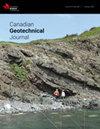Centrifuge modeling of slope failure induced by elevated gas pressure in wet municipal solid waste landfill
IF 3.5
3区 工程技术
Q2 ENGINEERING, GEOLOGICAL
引用次数: 0
Abstract
Understanding triggering mechanisms of slope failure is of great importance to the stability analysis and safety warning of waste landfill. This paper presents a centrifuge model test on slope failure induced by elevated gas pressure in wet landfill. The formation process of liquid level and gas pressure in the landfill is simulated by means of liquid and gas injections under a centrifugal acceleration of 66.7 g. The pore gas and liquid pressures under two-phase flow condition are monitored separately to clarify the instability process. It is found that the continuous gas injection makes the pore gas pressure increase to peak values of 83.0~100.8 kPa, which are higher than the peak liquid pressures of 61.3~75.6 kPa. The slope failure occurs when the pore gas pressure increases to the peak value and the corresponding shear strength decreases to the critical value. Although the gas injection raises the liquid level, the factor of safety of landfill slope will be overestimated if only considering the effect of liquid pressure. According to the response curves of displacement to gas pressure rise, the critical ratios of gas pressure to earth pressure are determined to be 0.74~0.84, which fall within the range of the prototype landfill. The difference between foam and air on pore pressure distribution is also calculated and discussed.湿式城市生活垃圾填埋场瓦斯压力升高引起边坡破坏的离心模拟
了解边坡破坏的触发机制对垃圾填埋场的稳定性分析和安全预警具有重要意义。本文采用离心模型试验对湿填埋区瓦斯压力升高引起的边坡破坏进行了研究。在离心加速度66.7 g的条件下,通过注入液体和气体,模拟了填埋场内液位和气压的形成过程。分别监测了两相流条件下的孔隙气液压力,阐明了失稳过程。结果表明,连续注气使孔隙气体压力达到83.0~100.8 kPa的峰值,高于液体压力61.3~75.6 kPa的峰值。当孔隙气体压力增大到峰值,对应的抗剪强度减小到临界值时,边坡发生破坏。注气虽然提高了液面,但如果只考虑液面压力的影响,填埋场边坡的安全系数会被高估。根据位移对气体压力上升的响应曲线,确定了气体压力与土压力的临界比为0.74~0.84,在原型填埋场的范围内。计算并讨论了泡沫与空气在孔隙压力分布上的差异。
本文章由计算机程序翻译,如有差异,请以英文原文为准。
求助全文
约1分钟内获得全文
求助全文
来源期刊

Canadian Geotechnical Journal
地学-地球科学综合
CiteScore
7.20
自引率
5.60%
发文量
163
审稿时长
7.5 months
期刊介绍:
The Canadian Geotechnical Journal features articles, notes, reviews, and discussions related to new developments in geotechnical and geoenvironmental engineering, and applied sciences. The topics of papers written by researchers and engineers/scientists active in industry include soil and rock mechanics, material properties and fundamental behaviour, site characterization, foundations, excavations, tunnels, dams and embankments, slopes, landslides, geological and rock engineering, ground improvement, hydrogeology and contaminant hydrogeology, geochemistry, waste management, geosynthetics, offshore engineering, ice, frozen ground and northern engineering, risk and reliability applications, and physical and numerical modelling.
Contributions that have practical relevance are preferred, including case records. Purely theoretical contributions are not generally published unless they are on a topic of special interest (like unsaturated soil mechanics or cold regions geotechnics) or they have direct practical value.
 求助内容:
求助内容: 应助结果提醒方式:
应助结果提醒方式:


